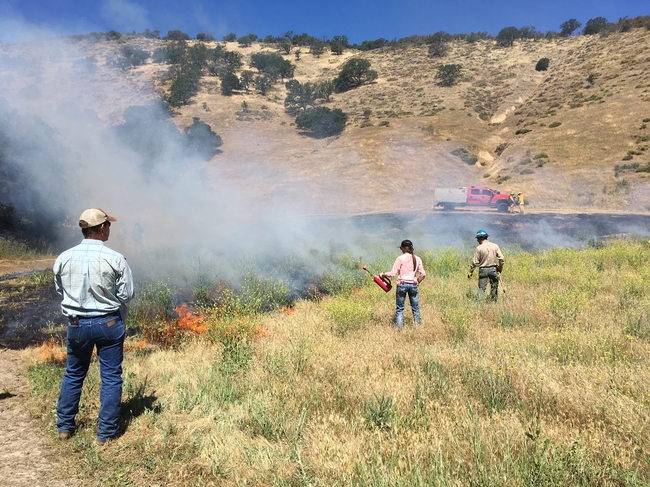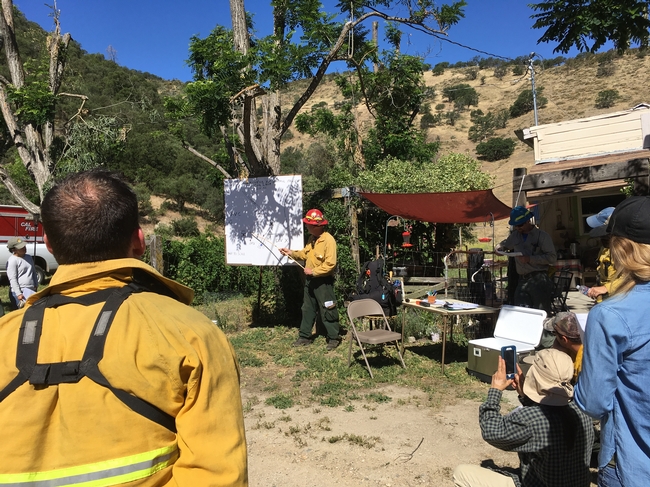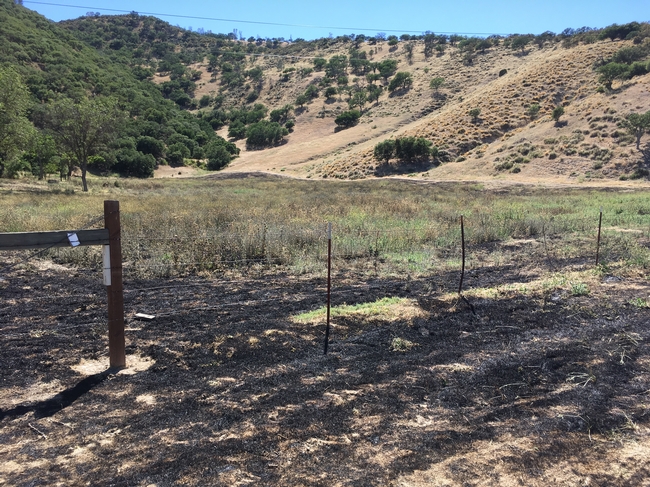Background: I've been told by locals that historically, landowners in San Benito and Monterey counties jointly burned 50,000 to 60,000 acres per year. But over time, burning on private land declined. Landowners started having difficulty getting permits to burn their own land and came to rely on CAL FIRE's Vegetation Management Program (VMP), which has limited capacity, to burn their lands.
The discussion about prescribed fire on private lands was revitalized at the San Benito Weed Management Area's Annual Continuing Education Seminar for Ranchers (Rancher Seminar) in 2017. At that meeting David Frisbey, from the Monterey Bay Air Resources District, gave presentations about smoke management permits and CAL FIRE's VMP & Range Improvement (RI) program. The following year, at the 2018 Rancher Seminar, David Frisbey returned to discuss smoke management and Lenya Quinn-Davidson, UCCE Fire Advisor from Humboldt County, gave a presentation about Humboldt County's recently developed Prescribed Burn Association (PBA). A PBA is similar to the Range Improvement Associations that used to be more common throughout the state. It's a landowner-led organization that also includes volunteer fire departments, non-profits, and agencies who work together to conduct prescribed burns, primarily on private land.
The two Rancher Seminar meeting sparked enough interest that UCCE collaborated with the San Benito Working Landscapes Group (SBWLG) to host a half day meeting on March 13, 2019, focused entirely on prescribed fire. The momentum continued building after the SBWLG meeting. Lenya Quinn-Davidson and Jeff Stackhouse, UCCE Livestock and Natural Resources Advisor, both from Humboldt County, offered their time and some grant funding to help us hold a 2-day prescribed fire workshop San Benito County on June 5 and 6, 2019. They have conducted more than 1,000 acres of prescribed burns over the past couple years with the Humboldt County PBA. We were lucky enough to have both of them join us in San Benito County for the entire workshop.
The Workshop: Day 1 of the workshop was an all-day class room session at the Hollister Vets Building with presentations about how the Humboldt County PBA was created and how it functions; smoke management permits; CAL FIRE's VMP and RI options; developing burn plans; burn unit preparation; fire weather; personal protective equipment (PPE); weed control with fire and more! Steve Davis with the Central Coast Prescribed Fire Council joined us and gave a talk at the meeting. He has a wealth of information about the history of prescribed fire in San Benito and Monterey counties.
On Day 2 of the workshop, we conducted a 2.7-acre prescribed burn on a ranch in Bitterwater, which was led by burn boss Phil Dye. The primary goal of the burn was to provide a hands-on prescribed burn training. We also had the goal of controlling yellow starthistle, which is a problem weed on the property. Phil developed a detailed burn plan that outlined the goals and objectives of the burn, the prescription (e.g. temperature, relative humidity wind speed, etc. required for the burn to be implemented), safety plan, contingency plan, etc. He also developed an incident action plan that identified each participant and their role for the day, information about personal safety, a medical plan in case of emergency, etc.
About 50 ranchers, landowners, and agency staff participated in the burn. In addition, three agencies provided fire engines for the burn: there was a CAL FIRE engine out of the Beaver Dam station led by Matt Johnson; a Hollister City/San Benito County Type 6 engine led by Captain Andrew Henderson; and an engine from East Bay Municipal Utilities District led by Wade Chambers. A few ranchers brought large water tanks on the back of their pickup trucks, as did Pinnacles National Park and Audubon Canyon Ranch.
Workshop participants had a wide range of experience. Many people had never participated in a prescribed burn before, while some had been on a few burns, and others were very experienced with years of training. Everyone had the opportunity to use hand tools, light the fire with a drip torch, and use a hose. Inexperienced people were always paired with an expert to guide them through each task. On a prescribed burn, there is a job for everyone, regardless of their fire experience or ability. People with limited mobility can still participate. They can do things like take weather readings throughout the day, supply water from the back of their trucks to the fire hoses, bring people drinking water, or help with other logistics!
If you missed the workshop, here's a link to the agenda and presentations from Day 1 (class room day) and the burn plan and incident action plan from Day 2 (burn day): http://cesanbenito.ucanr.edu/livestock/LNRResources/.
Yellow starthistle control: In addition to providing training, the burn was intended to control yellow starthistle. Research has shown that fire can kill yellow starthistle plants (DiTomaso and Kyser et al. 2013). The best time to burn is when you first start seeing flowers. Seeds are not yet viable at that time. Yellow starthistle plants will still be green at the time of the burn, but if the burn is hot enough, within about a week, you'll see the plants begin to droop and die (Johnson, pers comm.). That means you won't get seed production the year of the burn. Unfortunately, because of high soil moisture due to late rains; high humidity on the day of the burn; and a substantial number of summer mustard plants in the field that were still green, the fire didn't get hot enough on our burn day to kill the majority of the yellow starthistle plants. But, because our trainers were from out of town and because the primary goal was training, we went ahead with the burn, even though we knew it would not be as effective as we had hoped. We will follow up next year with an herbicide treatment.
Fire stimulates yellow starthistle seeds to germinate the next fall, so you'll see a lot of seed production the next year (DiTomaso et al. 2006). Because of the high levels of germination, it's necessary to follow-up with some kind of control, either another burn or herbicide. We plan to follow up with Capstone. This herbicide is combination of triclopyr amine (Garlon 3A) and aminopyralid (Milestone). We chose this herbicide because it is expected to control yellow starthistle and summer mustard, which are both common in the field. We will spray when the plants are in the seedling or rosette stage, and before they have bolted. We anticipate that spot-spraying will be needed in the years following the herbicide treatment.
Next Steps: Because so many people in San Benito and Monterey counties are interested in prescribed fire, there is the potential to develop a Prescribed Burn Association. UCCE is partnering with Jamie Tuitele-Lewis from the Resource Conservation District of Monterey County to develop a list of people who are interested in helping develop or participate in a PBA. Jamie and I will hold some initial stakeholder meetings. We also plan to submit a proposal to CAL FIRE'S Fire Prevention Grants Program to try to get funds to help us move forward with development of a PBA. Hopefully the request for proposals will be out late-summer.
Get involved: If you are interested in getting involved in landowner-led prescribed burning in San Benito and Monterey counties, please feel free to contact me at drorao@ucanr.edu or 831-389-4397 x14. You can also get in touch with Jamie at jtlewis@rcdmonterey.org or (831) 975-7775.
References
DiTomaso, J.M., G.B. Kyser et al. 2013. Weed Control in Natural Areas in the Western United States. Weed Research and Information Center, University of California. 544 pp.
DiTomaso, J.M, G. B. Kyser, and M. J. Pitcairn. 2006. Yellow starthistle management guide. Cal-IPC Publication 2006-03. California Invasive Plant Council: Berkeley, CA. 78 pp. Available: www.cal-ipc.org.
Johnson, B. 2019. Personal communication, June 2019. Johnson is with the National Park Service.
This article was originally published in Livestock & Range
Author - San Benito County Director and Area Livestock and Natural Resources Advisor



